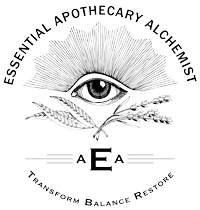The method for extracting the vital essences from plant materials is an ancient one and has its roots in the alchemical sciences. The process of distillation, is a profoundly alchemical process, involving all the elementals. Each element is necessary to coax out the plant's life energies in this process of transformation. We begin with a copper still [metal elemental], into which we add plant materials [wood elemental], and spring water [water elemental]. The still is then heated [fire elemental], to cause steam [air elemental], where the plant material is broken down to release it's essence. The water that is released from the still is the most yin (feminine) aspect of the transformation, and the essential oil that is suspended on top of the water is the most yang (masculine) aspect of the process. Each of these transformed products offer very specific uses. Today we will focus on the essential oil aspects of distillation.
When you apply essential oil perfumes, you are literally changing your body's chemistry. It is well known that essential oils have remarkable effects on the body organs, the skin, the mood via the limbic system (a complex system of nerves and networks in the brain, involving several areas near the edge of the cortex concerned with instinct and mood), and all other systems of the body. Essential oils are some of the most concentrated natural plant medicines available. Why would anyone want to wear a chemically derived fragrance that can do none of these, and most likely contains toxic petrochemicals? The tell tale sign of a synthetically derived perfume is that it will last on the skin, hair, your clothes for a very long time and the fragrance will change very little. The volatility of pure essential oils leads to perfumes that change on the skin with time, and will dissipate naturally. Perfumes made from pure essences interact in amazing ways and it may be said that the influences of the weather, the heavenly bodies, and the mood and intent of the perfumer all impact these volatile molecules.
Composition of a harmonious song [finished perfume], is the thoughtful blending of top, middle, and base notes. These complex arrangements in the right combinations make for a lovely fragrance. Top notes are lighter in fragrance and usually dissipate quickly. They are highly volatile, and fast acting. Citrus oils are good examples of top notes. Middle notes give body and balance to a perfume. Mid notes offer a warm and soft aroma to a perfume composition. Green plant materials are typical of middle notes. Base notes are heavier and long lasting, and are intense in character. Base notes encourage other lighter notes to linger. Woods, roots, and resins are characteristically base note in nature. Some essential oils act as fixatives, meaning they stabilize the molecules of a perfume and increase the longevity of the fragrance, especially the lighter molecules of the top notes. Essential oils high in sesquiterpene molecules like sandalwood and myrrh have been used for thousands of years for their fixative properties.
A perfume can have a focus of top, middle, or base notes, but often to balance a well rounded perfume, the top, mid, and base notes will also be added. When I am customizing a composition for a client I usually begin with the top notes. We smell directly from the bottles the highly volatile notes of blood, sweet, and bitter orange varieties. We take in the subtle differences of pink and white grapefruit, then savor lime, and bergamot for example. Next the middle or heart notes are gathered, enjoyed and selected. Heart notes like clary sage, lavender, ylang ylang, jasmine, and rose geranium are a small sampling of middle notes. And finally base notes like patchouli, benzoin, vanilla, tonka bean, vetiver, frankincense, and rose wood fill out the base aspects of the perfume.
This should not however dissuade you from procuring a treasure of this nature. Using a natural fragrance, especially one concocted specifically to your unique sensibilities, will literally transform your body, mind, and spirit... Isn't this the definition of ALCHEMY?

Back to BLOG